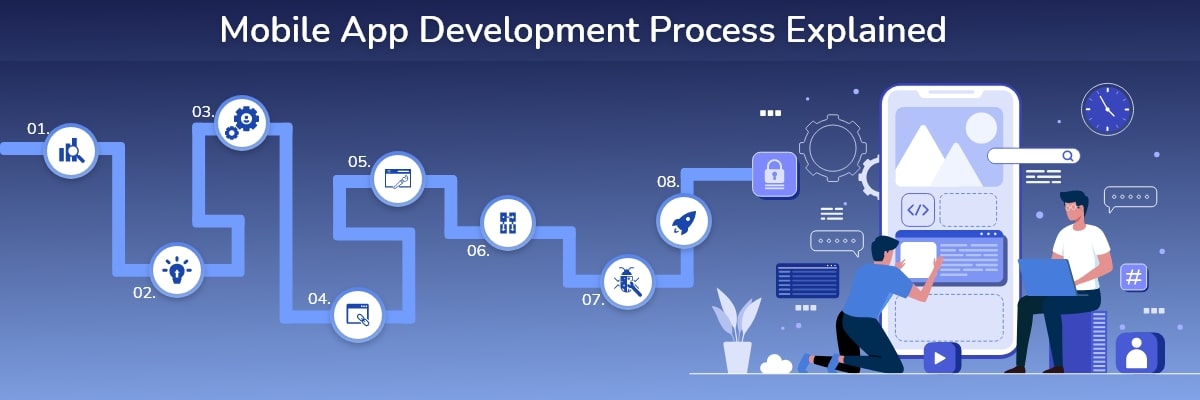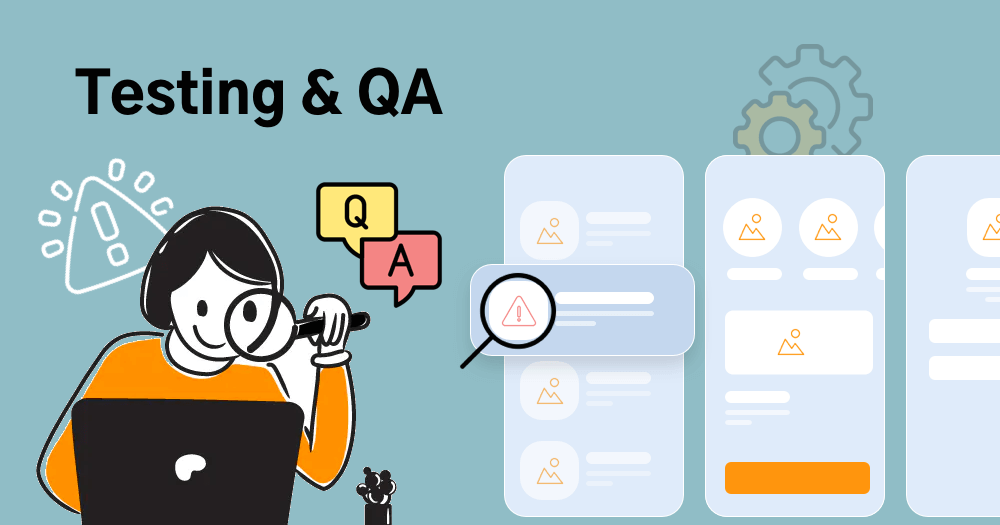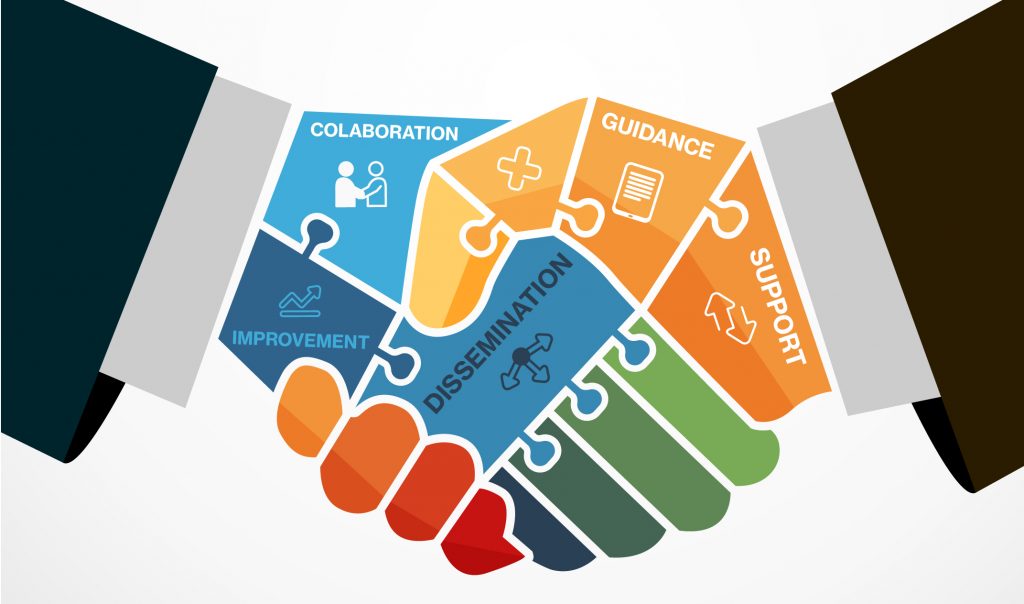It is predicted that in 2022, mobile apps will generate approximately $693 billion in revenue through app stores and in-app advertising.
While many companies are striving to capitalize on this trend, not all of them know how to successfully create an app. Success in the competitive landscape of these growth predictions can become a reality for your company, but only if supported by a well-developed mobile app development process.
An effective mobile app development process encompasses more than six key stages. In this article, we will take a closer look at each of them.
Regardless of the size and scope of your project, following this development process, when refined, can drive the success of your mobile app development initiative.
|
Choosing the right mobile app development platform |
- Strategy
The first step in the mobile app development process is defining a strategy to turn your idea into a successful app. You may include a significant part of this in your company's overall dynamic strategy. Since the goals of an app may differ from one to another, there's still a specific impact on your overall strategy that needs to be addressed throughout the development process.
In this stage, you:
- Identify the app's target users.
- Conduct research about the competition.
- Define the app's goals and objectives.
- Choose a mobile platform for your app.
On average, developing a mobile app can take between 3 to 9 months, depending on the type of business and the app's requirements. Your strategy helps focus your vision on a clear image of your app idea. Considering this, you can proceed to the next stage of the mobile app development process.
2. Analysis and Planning
In this stage, your app idea begins to take shape and becomes a real project. Analysis and planning begin with defining use cases and getting detailed functional requirements.
Once you've identified your app's requirements, create a product roadmap. This involves prioritizing the mobile app requirements and grouping them into delivery milestones. If time, resources, or costs are a concern, define your Minimum Viable Product (MVP) and prioritize it for the initial launch.
Part of the planning phase includes identifying the skill sets needed to kickstart your app development. For example, mobile platforms like iOS and Android use different development technologies. If your goal is to create a mobile app for both iOS and Android, your mobile development team should consist of iOS developers and Android developers.
Have you not chosen a name for your app yet? Mobile app names, like domain names, need to be unique in each app store. Research the app store for each app and make sure your app's name hasn't been taken!

3. UI/UX Design
The goal of designing a mobile app is to provide seamless and aesthetically pleasing user experiences.
The success of a mobile app is determined by how users engage with and benefit from all its features. The objective of UI/UX design for a mobile app is to create excellent user experiences that make your app interactive, visually appealing, and user-friendly.
Structure and Workflow:
The first step in the mobile app design process is determining the data your mobile app will display to users, the data it will collect, user interactions with the final product, and user journeys within the app.
For companies, mobile apps have users with different roles and permissions, and it's crucial to incorporate these rules as part of your app's information architecture. Workflow diagrams help identify any potential user interactions with the app and access paths.
These three stages lay the foundation for a successful mobile app development process. They help ensure that your app aligns with your business goals, addresses user needs, and provides an outstanding user experience. In the following stages of development, you'll move from planning and design to actual development, testing, and deployment.
Wireframes
Mobile app designers often start the app design process with sketches on paper. Wireframes are digital representations of those sketches. Wireframes are conceptual layouts—visual structures for your app's functionality.
In wireframes, the focus is more on aesthetics and user experience rather than on detailed designs and color schemes. Creating wireframes is a quick and cost-effective approach to designing app layouts and iterating on them in the design review process. When creating wireframes, you need to consider the specific device design. So, whether your app will be used on iPhones, iPads, or Android smartphones and tablets, it provides a visual and tailored experience for the user.
Style Guide
Style guides are documents where app design standards, from your company's branding rules to navigation icons, are documented.
Style guides include:
- Which font family your app's text uses.
- How the color scheme will be.
- How your company's branding will be reflected in app design.
Style guides assist in the app design strategy. Creating a style guide early on as part of the mobile app development process improves the productivity of your mobile app developers. Additionally, following a style guide helps maintain the appearance and feel of your app. As part of your app design, you should consider design guidelines from Apple for iOS apps and from Google for Android apps.

Mockups
Mockups, or high-fidelity designs, are the final visual design renders of your app's UI. Mockups are created by applying your style guide onto the app frames. As your app design begins to finalize, expect further refinements in information architecture, workflows, and aesthetics.
Prototypes
While mockups demonstrate the functionality of your mobile app using static designs, they can be turned into interactive prototypes using tools like Invision and Figma. Prototypes are valuable for simulating the expected user experience and app workflow. While prototype development can be time-consuming, the efforts are worthwhile as they provide early tests of your app's design and functionality. Often, prototypes help identify changes in proposed app functionality.
Development of the Mobile App
Planning is an integral part of this stage in the mobile app development process. Before diving into actual development/programming efforts, you need to:
- Define the technical architecture.
- Choose a technology stack.
- Define development milestones.
A typical mobile app project is composed of three essential parts: the Back-End/Server technology, APIs, and the Mobile App Front-End.
Back-End/Server Technology
This part includes the database and server-side components necessary to support your mobile app's functionality. If you are using an existing back-end platform, adjustments may be required to support the desired functionality.
APIs
Application Programming Interfaces (APIs) provide a way for the app to communicate with the server/database.
Mobile App Front-End
The mobile app front-end is the native part that the end-user will interact with. In most cases, mobile apps comprise interactive user experiences that use an API and back-end to manage data. In some cases, where an app needs to work offline, the app may use local data storage.
You can use almost any web programming language and database technology for the back-end. For native mobile apps, you'll need to choose the technology specific to each mobile platform's operating system. iOS apps can be developed using Objective-C or Swift. Android apps are primarily built using Java or Kotlin.
There are multiple programming languages and technologies available for mobile app development, and the key is to choose the technology that best suits your mobile app.
Mobile technologies evolve rapidly with new versions of mobile platforms being released much faster. Additionally, new mobile devices are launched every few months. With the rapid changes in platforms and devices, staying up-to-date with the skills required for mobile app development is crucial. If time-to-market is a priority, consider an agile development approach. This approach supports frequent software releases with full functionality. Defining development milestones as part of your mobile app development process ensures frequent support.

Testing
Performing Quality Assurance (QA) testing throughout the mobile app development process ensures that apps are stable, usable, and secure. To ensure comprehensive QA testing of your app, you should first prepare test cases that will check all aspects of the app's functionality.
Similar to how use cases drive the mobile app design process, test cases drive app testing. Test cases are for executing testing phases, recording test results for quality evaluation, and tracking fixes for retesting. It's a good practice to involve your QA team in the analysis and design phases. Familiarity with the requirements and functional objectives of your app helps QA testers produce accurate test cases.
Your app should undergo the following types of testing to deliver a high-quality, robust solution:
- User Experience Testing
One crucial step in mobile app testing is ensuring that the final execution aligns with the user experience created by the app design team. The visual elements, workflow, and interactions of your app are what users will experience firsthand. Make sure your app uses fonts, styles, color schemes, data layering, icon designs, and navigation that align with your users' expectations. Ensuring that your app complies with the main design guidelines will have a direct impact on user acceptance.
- Functional Testing
The accuracy of your mobile app's functionality is crucial for its success. Predicting the behavior and usage scenarios of each end-user can be challenging.
Functional testing involves making sure that users can use the features and functionalities of your app without encountering any issues. It can be broken down into system testing (ensuring the app functions as a whole) and unit testing (ensuring individual app functions work correctly). If you're building an app for both iOS and Android platforms, your functional testing should include comparing features between the two versions of your mobile app.
- Performance Testing
There are various quantitative criteria for measuring the performance of your app:
- How responsive is your app to user requests?
- How quickly do app screens load?
- Does your app drain the phone's battery or cause memory leaks?
- Does your app efficiently use network bandwidth?
- Is your app larger in size than it should be?
Even when your app meets basic performance benchmarks, simulate maximum user, app, API, and backend load to ensure your app can handle the load and still perform well under increased usage.
- Security Testing
Security is crucial for organizational mobile apps. Any potential vulnerability can lead to hacking attempts. Many companies employ external agencies to conduct comprehensive security testing on their apps. Your QA and development teams can also take several simple steps to secure your app.
If your app requires users to log in, the time they spend within the app should be tracked. If your app stores user data on the device for easy access upon re-entry, ensure you're using a reliable service. For example, the iOS development platform provides the Keychain feature for securely storing user account details for a specific app.
Data input forms in your mobile app should undergo testing to ensure data leakage doesn't occur.
- Device and Platform Testing
On average, new mobile devices with new hardware, operating systems, and designs enter the market every 12 months. Mobile operating systems are updated every few months.
Several manufacturers, such as Samsung, LG, HTC, Motorola, use the Android platform, but they customize it for their specific devices. Each device varies in size and shape.
Compare this to Apple, which has a more controlled environment since it controls both hardware and software.
Your mobile app should be tested on various mobile devices or device emulators to ensure a smooth performance for all users.

- Deployment and Support
Releasing a native mobile app involves submitting your app to app stores: the App Store for iOS apps and Google Play for Android apps. However, before launching your mobile app, you'll need a developer account on both the Apple and Google Play stores.
Publishing an app in an app store entails preparing metadata, including:
- Your app's title
- Description
- Category
- Keywords
- Launch icon
- App Store screenshots
After submission to the App Store, iOS apps go through a review process, which can take several days to weeks depending on your app's quality and adherence to iOS development guidelines. If your app requires users to log in, you'll need to provide a demo account as part of the submission process.
There's no such review process for Android apps, and they typically become available within hours of submission to the Google Play store.
Once your app is available in app stores, monitor its usage through mobile analytics platforms and track Key Performance Indicators (KPIs) to measure its success. Regularly review user-reported bug reports or other issues.
Encourage users to provide feedback and suggestions for your app. Prompt user support and frequent app improvements are vital to keep users engaged. Unlike web apps where modified versions can be instantly available to users, mobile app updates must go through the submission and review process. Additionally, with native mobile apps, you need to stay continuously updated with technological advancements and regularly update your app for new mobile devices and operating system platforms.
Conclusion
App development is an ongoing process, and after the initial launch, it continues with user feedback and additional feature development. TAP30 has been a leading mobile app development company in Iran, providing app development services to companies in various sectors, including finance, healthcare, construction, retail, consumer products, logistics, industrial engineering, and entertainment, among others. We follow this process for all the mobile apps we create. Adhering to this app development process ensures the successful launch of your organizational mobile app.
After reviewing the mobile app development process, what questions do you have about turning your idea into a successful app?
Feel free to share any questions or comments you may have!
If you'd like to discuss your mobile app development plans further, please don't hesitate to reach out to us.


